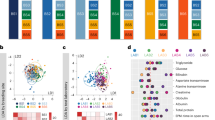Abstract
Experimental manipulations of rodents may result in unexpected adverse phenotypes that present problems from both regulatory and animal care–veterinary perspectives. The authors discuss the implications of unanticipated outcomes and describe a cage card–based tracking system used at the Harvard Medical School for the early detection and handling of unanticipated phenotypes in genetically altered rodents.
This is a preview of subscription content, access via your institution
Access options
Subscribe to this journal
We are sorry, but there is no personal subscription option available for your country.
Buy this article
- Purchase on Springer Link
- Instant access to full article PDF
Prices may be subject to local taxes which are calculated during checkout


Similar content being viewed by others
References
Floyd, E. in Microbial Status and Genetic Evaluation of Mice and Rats 116–118 (National Research Council, Washington, DC, 2000).
Dennis, M.B. Humane endpoints for genetically engineered animal models. ILAR J. 41(2), 94–98 (2000).
National Institutes of Health. NIH Guidelines: Recombinant DNA and Gene Transfer. Guidelines for Research Involving Recombinant DNA Molecules. http://www4.od.nih.gov/oba/rac/guidelines/guidelines.html.
Dennis, M.B. in Genetic Engineering and Animal Welfare: Preparing for the 21st Century (eds. Gonder, J.C., Prentice, E.D. & Russow, L.) 20–31 (Scientists Center for Animal Welfare, Bethesda, MD, 1999).
Dennis, M.B. Welfare issues of genetically modified animals. ILAR J. 43(2), 100–109 (2002).
Young, J. IACUC Issues Relevant to Managing Tg/KO Animals: A Veterinarian's Perspective. Proceedings of 2005 Annual IACUC Conference at the PRIM&R/ARENA Meeting, San Diego, CA, March 2005.
Hampshire, V. Definition of Pain and Distress and Reporting Requirements for Laboratory Animals 77–81 (National Research Council, Washington, DC, 2000).
Acknowledgements
Drs. David Lee-Parritz and Angeline Warner participated in the creation of the rodent cage-based records system. Technical assistance was provided by Lori Jasinski, LATG.
Author information
Authors and Affiliations
Corresponding author
Ethics declarations
Competing interests
The authors declare no competing financial interests.
Rights and permissions
About this article
Cite this article
Pritt, S., Cozine, K. & Warren, H. Management of unanticipated outcomes in transgenic mouse facilities. Lab Anim 35, 27–30 (2006). https://doi.org/10.1038/laban0406-27
Received:
Accepted:
Issue Date:
DOI: https://doi.org/10.1038/laban0406-27


